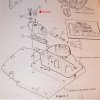OK, I'll skip the inner shaft seals. Checked the play today - there is just a tiny amount of end play in the right side - maybe a thousandth or two? Left side seems tight. Are the thrust washers hard to replace?
Another question - I was planning on getting brake lining kits and doing the riveting myself - any trick to this? I've done aircraft (solid) rivets, with a pneumatic hammer and bucking bar - how are these set?
Unrelated issue - I'm just finishing up rebuilding the three electronic instruments (fuel, ammeter, and H2O temp). If anyone needs any help doing this, I'll be glad to answer questions. Looks like a common failure on the fuel and H2O is to lose the ground (no pun intended) connection, which comes through the case. Notice that the U bracket on these instruments has a spring clip on the side - this is part of the ground path. The internal ground connection has to go through a brass plate that presses against the inside of the case. Unfortunately, this can corrode and break that connection, and the only way to fix that is to open up the case (more on this later). The two long screws coming out the back are of course the other two connections, one to 12 volts and the other to the sensor, which is a resistor to ground. These screws make connections internally to ring terminals, which also have a way of getting corroded and lose their connections. Fortunately, the screws are brass, so they will take solder if you get them hot enough. Clean a small area with a sharp knife or dremel so the solder has good metal to bond with. Of course, all this assumes you're inside the instrument, which requires that you peel back the lip on the front cover. This can be done with a small jewelers screwdriver. Leave the last two nuts on the brass screws while you're doing this so the insides don't bounce around.
If all that sounds like too much trouble, I guess you can get a new one for maybe $80?
PG



